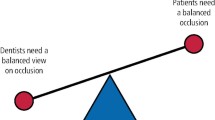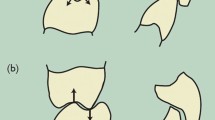Abstract
Data sources
Medline, Scopus and Cochrane Library databases supplemented by searches in the journals; American Journal of Dentistry, Clinical Oral Investigation, International Journal of Prosthodontics, Journal of Dental Research, Journal of Oral Rehabilitation, Journal of Prosthodontics, Journal of Prosthodontic Research, Journal of Advanced Prosthodontics and Journal of Prosthetic Dentistry.
Study selection
Randomised controlled trials (RCTs) or prospective studies comparing bilateral balanced occlusion (BBO) with other schemes, eg lingual occlusion (LO) canine guidance (CG) and neutral-centric or zero-degree (ZD).
Data extraction and synthesis
One reviewer extracted the data and two reviewers assessed risk of bias using the Newcastle-Ottawa scale for non-randomised studies and the Cochrane risk of bias tool for RCTs. A narrative summary of the findings was presented.
Results
Seventeen studies, 11 RCTs and six prospective studies involving a total of 492 were included. Average follow-up period was 2.96 months (range 1-6 months). Six RCTs were considered to be at low risk of bias, two at unclear risk and three at high risk. Studies compared BBO with LO, CG and ZD. Twelve out of 16 studies reported on quality of life and patients satisfaction.
Conclusions
The present systematic review indicated that BBO does not confer better quality of life/satisfaction or masticatory performance and muscle activity. Thus, lingualised occlusion can be considered a predictable occlusal scheme for complete dentures in terms of quality of life/satisfaction and masticatory performance, while canine guidance can be used to reduce muscular activity.
Similar content being viewed by others
Log in or create a free account to read this content
Gain free access to this article, as well as selected content from this journal and more on nature.com
or
References
Eric J, Tihacek Sojic L, Bjelovic L, Tsakos G . Changes in Oral Health Related Quality of Life (OHRQoL) and satisfaction with conventional complete dentures among elderly people. Oral Health Prev Dent 2017; 15: 237–244.
Higgins JP, Green S . Cochrane Handbook for Systematic Reviews of Interventions: Cochrane Book Series. Cochrane Handbook for Systematic Reviews of Interventions: Cochrane Book Series. 2008.
Shrier I, Boivin JF, Steele RJ, et al. Should meta-analyses of interventions include observational studies in addition to randomized controlled trials? A critical examination of underlying principles. Am J Epidemiol 2007; 166: 1203–1209.
Farias-Neto A, Carreiro Ada F . Changes in patient satisfaction and masticatory efficiency during adaptation to new dentures. Compend Contin Educ Dent 2015; 36: 174–177; quiz 178, 190.
Eberhard L, Oh K, Eiffler C, et al. Adaptation to new complete dentures - is the neuromuscular system outcome-oriented or effort-oriented? Clin Oral Investig 2018; 22: 2309–2317.
Critchlow SB, Ellis JS . Prognostic indicators for conventional complete denture therapy: a review of the literature. J Dent 2010; 38: 2–9.
Diehl RL, Foerster U, Sposetti VJ, Dolan TA . Factors associated with successful denture therapy. J Prosthodont 1996; 5: 84–90.
Author information
Authors and Affiliations
Additional information
Address for correspondence: Cleidiel Aparecido Araujo Lemos, Department of Dental Materials and Prosthodontics, Araçatuba Dental School, UNESP - Univ Estadual Paulista, Araçatuba, Safio Paulo, Brazil. E-mail: cleidiel@gmail.com
Lemos CAA, Verri FR, Gomes JML, Santiago Júnior JF, Moraes SLD, Pellizzer EP. Bilateral balanced occlusion compared to other occlusal schemes in complete dentures: A systematic review. J Oral Rehabil 2018; 45: 344–354. doi: 10.1111/joor.12607. [Epub ahead of print] Review. PubMed PMID: 29314199.
Rights and permissions
About this article
Cite this article
Loh, P., Levey, C. Occlusal schemes for complete dentures. Evid Based Dent 19, 116–117 (2018). https://doi.org/10.1038/sj.ebd.6401346
Published:
Issue date:
DOI: https://doi.org/10.1038/sj.ebd.6401346



